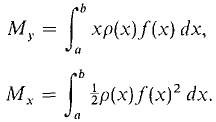| The ebook Elementary Calculus is based on material originally written by H.J. Keisler. For more information please read the copyright pages. |

|

Home  Applications of the Integral Applications of the Integral  Some Applications to Physics Some Applications to Physics  Moments - Two Dimensions Moments - Two Dimensions |
|||||






|
|||||
Moments - Two Dimensions
Figure 6.6.8 A mass m at the point (x0, y0) in the (x, y) plane will have moments Mx about the x-axis and My about the y-axis (Figure 6.6.8). They are defined by Mx = my0, My = mx0. Consider a vertical length of wire of mass m and constant density which lies on the line x = x0 from y = a to y = b. The wire has density
The infinitesimal piece of the wire from y to y + Δy shown in Figure 6.6.9 will have mass and moments Δm = ρ Δy, ΔMX ≈ y Δm = yρ Δy (compared to Δy), ΔMy ≈ x0 Δm = xoρΔy (compared to Δy).
Figure 6.6.9 The Infinite Sum Theorem gives the moments for the whole wire,
We next take up the case of a flat plate which occupies the region R under the curve y = f(x), f(x) ≥ 0, from x = a to x = b (Figure 6.6.10). Assume the density
Figure 6.6.10 ρ(x) depends only on the x-coordinate. A vertical slice of infinitesimal width Δx between x and x + Δx is almost a vertical length of wire between 0 and f(x) which has area ΔA and mass Δm ≈ ρ(x) ΔA ≈ ρ(x) f(x) Δx (compared to Δx). Putting the mass Δm into the vertical wire formulas, the moments are ΔMy ≈ x Δm ≈ xρ(x) f(x) Δx (compared to Δx), ΔMx ≈ ½(f(x) + 0) Δm ≈ ½ρ(x)f(x)2 Δx (compared to Δx). Then by the Infinite Sum Theorem, the total moments are
The center of mass of a two-dimensional object is defined as the point (x, y) with coordinates x = My/m, y = Mx/m. A single mass m at the point (x, y) will have the same moments as the two-dimensional body, Mx = my, My, = mx. The object will balance on a pin placed at the center of mass. If a two-dimensional object has constant density, the center of mass depends only on the region R which it occupies. The centroid of a region R is defined as the center of mass of an object of constant density which occupies R. Thus if R is the region below the continuous curve y = f(x) from x = a to x = b, then the centroid has coordinates
where A is the area
The following principle often simplifies a problem in moments. If an object is symmetrical about an axis, then its moment about that axis is zero and its center of mass lies on the axis. PROOF f(-x) = f(x), ρ(-x) = ρ(x). Then
Also, x = My/m = 0.
Figure 6.6.12 Symmetry about the y-axis
|
|||||
Home  Applications of the Integral Applications of the Integral  Some Applications to Physics Some Applications to Physics  Moments - Two Dimensions Moments - Two Dimensions |
|||||
Last Update: 2010-11-25













